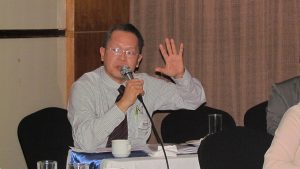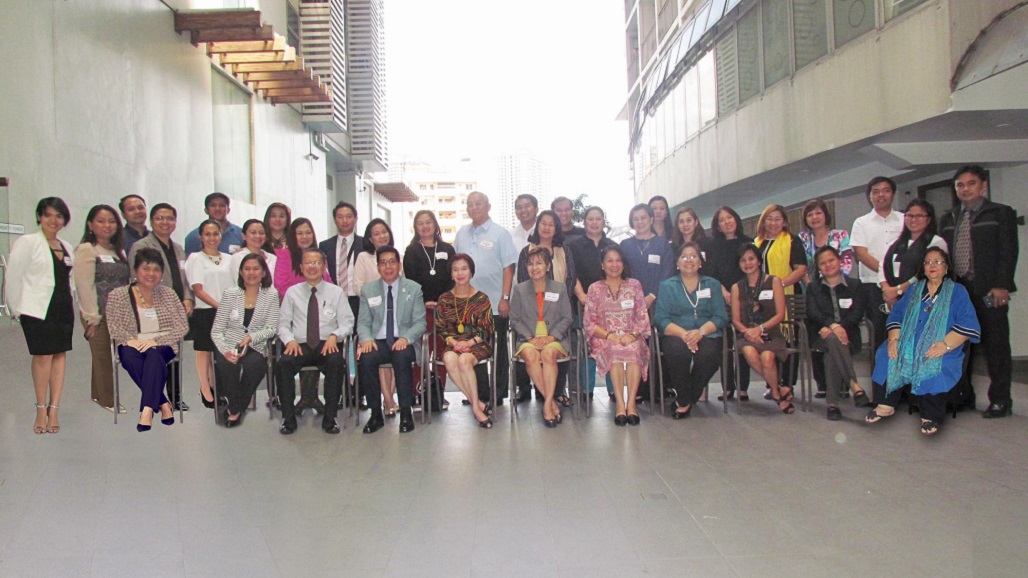Manila – CACCI Deputy Director-General and ABA Deputy Secretary Mr. Amador Honrado Jr. attended the Association Management Course organized by the Philippine Council of Associations and Association Executives (PCAAE) on February 16, 2017 at the A. Venue Hotel in Makati City, Philippines.
Attended by some 35 representatives of various member associations of PCAAE, the one-day course is part of the Certified Profession Association (CPAE) Program conducted by the PCAAE for its members and associates. In its invitation letter to CACCI and ABA, the PCAAE pointed out that association management is a distinct field of management because of the unique environment of associations in which their “owners” are dues-paying members.
“Association executives/managers are responsible for many tasks similar in other organizational contexts such as human resource management, financial management, meeting management, IT management, and project management. However, other aspects of management to be covered by the program which are unique to association managers include: membership recruitment, retention and engagement; membership value proposition; development of non-dues revenue and stakeholder relationship,” the PCAAE explained in its course promotional material.
The PCAAE is a membership organization serving the interest of institutions and professionals that manage business, trade, professional, philanthropic, scientific, medical, educational, technical, social welfare, agricultural and other non-profit organization.
 I. Speakers
I. Speakers
The main resource persons were:
- Mr. Octavio Peralta, PCAAE CEO and Founder and Secretary General of the Association of Development Financing Institutions in Asia and the Pacific (ADFIAP)
- Mr. Enrique Florencio, Knowledge Resources Executive and Sustainability Officer, ADFIAP
II. Course Coverage
The one-day course covered three major topics, namely: (a) Roles and Activities of Associations; (b) Attributes of a Successful Association; and (c): Why Associations Fail
III. Roles and Activities of Associations
The topics discussed during this session included the following: (a) Scope of Purposes; (b) Strategic Goal; (c) Constituent Relationship; (d) Perspective on Relevance; (e) Types of Initiatives Supported; (f) Posture relative to financial opportunity; (g) Sources of funding; (h) Application of funds.
 The session speaker Mr. Octavio Peralta noted that the Association Vision is what the association aspires to be ; its vision statement is where the organization wil be in the distant future, the results it wants to achieve, or the measurable impact it wants to make ; and the vision keeps the association on course to fulfill its purpose.
The session speaker Mr. Octavio Peralta noted that the Association Vision is what the association aspires to be ; its vision statement is where the organization wil be in the distant future, the results it wants to achieve, or the measurable impact it wants to make ; and the vision keeps the association on course to fulfill its purpose.
The speaker pointed out the roles of the Association, its members, its Board, its President or Chairman, its Executive Officer, and its staff as follows :
- Associations accomplish their goals with the help of the staff, volunteers (including the Board), and members .
- Member elect the Board to act on their behalf.
- The Board sets directions and make cdecisions on behalf of the Association, and delegates work to volunteer committees, task forces or staff.
- The President (or Chairman) ensures that the Board fulfills its responsibilities.
- The Executive Officer (CEO, Executive Director, or Director-General) implements Board decisions and reports directly to the Board.
- The staff do the work of the association and reports to the executive Officer
- Whether staff or volunteer, it is important to udnerstand specific roles to avoid confusion or conflict.
- Each key stakeholder plays a specific role :
Members decide who will be in the Board
Board decides what are the right things to do
Staff implements the Board decisions and decide how things are to be done - By working together, the members, Board and staff ensure that the association achieves the common puspose of its members.
The speaker also noted that :
- Association management is a distinct field of management because of the unique environment of associations. Associations are unique in that the ‘owners’ are dues-paying members. Members also govern their association through an elected Board, along with association committees, task forces, etc.
- Typically, the Board selects, retains and evaluates a chief executive officer or an executive director who is resposible for the day-to-day management association and paid staff.
- Managers within the association environment are responsible for tasks similar to other organization contexts such as : human ressource management, financial management, IT management, and project management.
 Regarding membership aspects, the speaker observed that :
Regarding membership aspects, the speaker observed that :
- Member acquisition include awareness and recruitment. Awareness is when a prospective member first discovers the association, i.e., recognition by the segment or profession it serves. Recognition, assuming it is positive, can make the acquisition efforts much easier and more successful. Recruitment is when the prospective member chooses to try out the association.
- Successful recruitment involves understanding target prospects – who, what, where, when and how they are reached. This is the most important component in member prospecting. It also involves the message from research-based knowledge of an association’s ‘indispensability’ – the one thing it does better than anybody else, value- or benefit-oriented, not feature-oriented.
- Successful recruitment involves creative design that drives interest and promotes receptivity to the message. The offer seeks to strike a balance between what prospects will give up (membership dues) and what they will receive in exchange (benefits) by becoming a member; often the final and most critical hurdle in a prospect’s decision process.
- Member retention includes 3 steps: engagement, renewal, and reinstatement. If associations are to grow, strong acquisition programs should be followed by successful retention programs, and lapsing members should be rescued by reinstatements. If retention is low, particularly first year conversion rates, associations can quickly exhaust qualified new member prospect lists. Once prospects have tried membership and elected to discontinue it, winning them back a second time can be difficult.
Engagement is when members feel “they belong”. Successful engagement programs set the stage for successful renewals by helping members become benefit users. Research shows that members who have a “non-dues transaction” with their association are far more likely to continue their membership. A concerted engagement series of month-by-month contacts can increase retention rates substantially.
Renewal is when lapsing members decide whether to keep being a member. Renewals are an important foundation for growth. The act of deciding to renew or not is a vote of confidence or no confidence. The renewal process should be continued until the cost of sending renewal reminders exceeds the dues value. However, many successful organizations go even further – sending renewal notices until the cost exceeds the lifetime value of their dues payments.
Reinstatement is when ex-members agree to return. Reinstatements are a regular component of membership growth programs to bring the membership lifecycle in full circle. The most likely member to return to an association is the one who most recently left. It is much easier and cheaper to entice former members back than it is to find new prospects and turn them into members. Reinstatement programs must present fresh messaging and perhaps new offers for lapsed members to reconsider the decision to join; or join once again if they forgot, or somehow unintentionally did not renew.
 IV. Attributes of a Successful Association
IV. Attributes of a Successful Association
This session identified some of the important characteristics of a successful association. According to the speaker, these include:
- Customer service culture – A “we are here to serve you” approach is built into the organizational structure and processes.
- Alignment of products and services with purpose – Service offerings are consistent with the organization’s purpose which remains central and unchanging even in the midst of changes in the external environment.
- Data-driven strategies – The organization not only gathers and analyzes information but also has effective processes for taking action based on what it has learned.
- Dialogue and engagement – An internal conversation continually occurs among staff, Board and members about the Association’s direction and priorities.
- The CEO as a broker of ideas – The CEO facilitates visionary thinking throughout the organization.
- Organizational adaptability – Remarkable associations learn from and respond to change; although willing to change, they also know what not to change.
- Alliance building – Associations that are secure and confident in their own right seek partners and projects that complement their purpose and mission.
V. Why Associations Fail
The discussions in this session focused on the common reasons for the failures of associations. According to the speaker, these include :
- Losing purpose focus – What is the association’s purpose? If it cannot be stated in one sentence, then there is a problem. A simple, clear and compelling purpose statement is the motivating force for the members, Board, staff and volunteers. Focusing on the purpose is crucial to defining the Association’s brand and formulating actions that will accomplish its objectives. So, write it down, visit it often, and share it by communicating it in your printed materials, presentations, events, websites, etc.
- Straying into the wrong business – Key to success is simple – do one thing and do it better than the competition. Many associations don’t follow this rule: whether it be running online training programs or publishing magazines, they stray into areas in which they have no expertise. Smart organizations understand the value of outsourcing whatever isn’t their core business.
- Failing to communicate benefits – Associations must remember that they need to communicate their benefits on an on-going basis so that their members feel connected to the cause. True member motivation is usually based on a response that is emotional and that makes people feel positive about belonging.
- Taking members for granted – Your members are your “customers”, and serving them well is important. Find new and personal ways to give prospects and members the tools and information they need to take full advantage of their membership. Send personalized email messages. Consider a telephone campaign. And make members feel special as often as possible.
- Pricing services inappropriately – Price connotes value. While associations need to be careful that they don’t price out their members, an association that is “on sale” can send the wrong message about quality and value. On the other hand, if your price is too high, they may decide not to join, or to join a similar, lower-priced organization.
- Giving potential members a free ride – It’s important to understand the differences between the ways in which ‘freeloaders’ anf participating members connect with the organization. There are some great ways to close the door to ‘free riders’ and provide incentives for them to join and become active members.
- Ignoring the competition – Be aware of your competitors and know what you need to do to keep up with them. When you stand side by side with your competition, what can you offer people that they can’t? This is your unique selling proposition (USP). If you have a number of different areas where you can provide something that your competitors can’t – spell them out.
- Resisting change – Change is a constant. With decreasing revenues and external pressures, associations are increasingly called upon to make dramatic changes. Be positive and consistent. Highlight the benefits of the change, as well as the new opportunities and challenges that the organization will face. Listen to the responses, address them promptly, and understand that the human aspect of change must be carefully managed in order to have effective results.
- Falling into merger mania – The strongest connection between an association and its membership is often the association’s name. Take that away, and the connection can be broken entirely. Mergers can lead to more streamlined business functions, combine limited resources and create a strong, and sensible new association. But make sure that the merger makes sense from all perspectives, and that your purpose and vision is not lost in organizational confusion.
- Accepting irrelevance – Sometimes associations are victims of their own success. Position your association in your members’ mind, remember the lessons of how to avoid failure, and use them for positive changes that lead to success.
VII. In summary
The speaker noted that for an organization to realize success from failure, (a) know why you exist and stay true to that purpose, (b) serve and appreciate your membership, and (c) keep your eyes amd ears attuned to what is around you. Remember that it is not the failure itself, but the failure to learn from it and move on, that is the biggest problem for an association.

